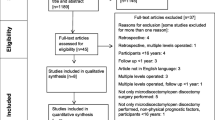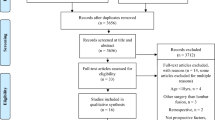Abstract
The objective of this systematic review is to summarize scientific evidence concerning the predictive value of bio-psychosocial risk factors with regard to the outcome after lumbar disc surgery. Medical and psychological databases were used to locate potentially relevant articles, which resulted in the selection of 11 studies. Each of these studies has a prospective design that examined the predictive value of preoperative variables for the outcome of lumbar disc surgery. Results indicated that socio-demographic, clinical, work-related as well as psychological factors predict lumbar disc surgery outcome. Findings showed relatively consistently that a lower level of education, a higher level of preoperative pain, less work satisfaction, a longer duration of sick leave, higher levels of psychological complaints and more passive avoidance coping function as predictors of an unfavourable outcome in terms of pain, disability, work capacity, or a combination of these outcome measures. The results of this review provide preliminary opportunities to select patients at risk for an unfavourable outcome. However, further systematic and methodologically high quality research is required, particularly for those predictors that can be positively influenced by multidisciplinary interventions.
Similar content being viewed by others
References
Abramovitz JN, Neff SR (1991) Lumbar disc surgery: results of the prospective lumbar discectomy study of the joint section of disorders of the spine and peripheral nerves of the American association of neurological surgeons. Neurosurgery 29:301–308
Asch HL, Lewis PJ, Moreland DB et al (2002) Prospective multiple outcomes study of outpatient lumbar microdiscectomy: should 75–80% success rates be the norm? J Neurosurg 96:34–44
Cherkin DC, Deyo RA, Bush T, Waddel G (1994) An internationl comparison of back surgery rates. Spine 19:120–126
Coskun E, Suzer T, Topuz O et al (2000) Relationships between epidural fibrosis, pain, disability and psychological factors after lumbar disc surgery. Eur Spine J 9:218–223
Croft PR, Papageorgiou AC, Ferry S et al (1996) Psychologic distress and low back pain: evidence from a prospective study in the general population. Spine 21:2731–2737
Dauch W, Fasse A, Bucher K et al (1994) Predictoren des Behandlungserfolges nach mikrochirurgischer operation lumbaler Bandscheibenvorfalle [Predictors of treatment success after microsurgical operation of lumbar intevertebral disc replacement]. Z Neurochir 55:144–155
Donceel P, Du Bois M (1999) Predictors for work incapacity continuing after disc surgery. Scand J Work Environ Health 25:264–271
Dutch Health Council (1999) Management van het lumbosacraal radiculair syndroom [Management of the lumbosacral radiculair syndrome]. The Hague Netherlands
Dzioba RB, Neville C (1984) A prospective investigation into the orthopaedic and psychological predictors of outcome of first lumbar surgery following industrial injury. Spine 614–23
Evers AW, Kraaimaat FW, Geenen R et al (2003) Pain coping and social support as predictors of long term functional disability and pain in early rheumathoid arthritis. Behav Res Ther 41:1295–1310
Evers AW, Kraaimaat FW, van Riel PL et al (2002) Tailored cognitive-behavioural therapy in early rheumatoid arthritis for patients at risk: a randomized controlled trial. Pain 100:141–153
Findlay GF, Hall BI, Musa BS et al (1998) A 10-year follow-up of the outcome of lumbar microdiscectomy. Spine 23:1168–1171
Frymorer JW (1992) Predicting disability from low back pain. Clin Orthop 279:101–109
Fulde E, Junge A, Ahrens S (1995) Coping strategies and defence mechanisms and their relevance for the recovery after discectomy. J Psychosom Res 39:819–826
Gallagher RM, Raugh V, Milhous R et al (1998) Determinants of return to work among low back pain patients. Pain 39:55–67
Gibson JNA, Grant IC, Waddel G (1999) The Cochrane review for lumbar disc prolapse and degenerative lumbar spondylosis. Spine 17:1820–1832
Giezen A, Bouter LM, Nijhuis FJ (2000) Prediction of return to work of low back pain patients sick listed for 3–4 months. Pain 87:285–294
Graver V, Ljunggren L, Loeb L et al (1992) Fibronilitical activity as a predictor of the outcome of prolapsed intervertebral lumbar disc surgery with reference to background variables: results of a prospective cohort study. Spine 17:1022–1027
Graver V, Ljunggren L, Malt U et al (1995) Can psychosocial traits predict the outcome of lumbar disc surgery when anamnestic and psychosocial risk factors are controlled for? Results of a prospective cohort study. J Psychosom Res 39:465–476
Graver V, Ljunggren L, Rasmussen F et al (1998) Background variables (medical, anthropometric and biological factors) in relation to the outcome of lumbar disc surgery. Scan J Rehab Med 30:221–225
Graver V, Haaland A, Magnaes B et al (1999) Seven year clinical follow-up after lumbar disc surgery: results and predictors of outcome. Br J Neurosurg 13:178–184
Groot KI, Boeke S, Berge H et al (1996) The influence of psychological variables on post- operative anxiety and physical complaints in patients undergoing lumbar surgery. Pain 69:19–25
Hanai F, Matsui N, Hongo N (1996) Changes in responses of wide dynamic range neurons in the spinal dorsal horn after dorsal root or dorsal root ganglion compression. Spine 21:1408–1414
Hasenbring M, Kuhlendahl D, Soyka D (1994) Risk factors of chronicity in lumbar disc patients: a prospective investigation of biologic, psychological and social predictors of therapy outcome. Spine 19:2759–2765
Hidebrandt J, Pfingsten M, Saur P et al (1997) Prediction of success from a multidisciplinairy treatment program for chronic low back pain. Spine 22:990–1001
Hoogendoorn WE, van Poppel MN, Bongers PM et al (2000) Systematic review of psychosocial factors at work and private live as risk factors for back pain. Spine 25:2114–2125
Hou S, Tang J, Chen H et al (2003) Chromic inflammation and compression of the dorsal root contribute to sciatica induced by intevertebral disc herniation in rats. Pain 105:255–264
Hurme M, Alaranta H (1987) Factors predicting the result of surgery for lumbar disc herniation. Spine 12:933–938
Ito T, Takano Y, Yusana N (2001) Types of herniated disc and clinical course. Spine 26:648–651
Jonssen B (1993) Patient-related factors predicting the outcome of decompressive surgery. Acta Orthop Scand 6469–70
Junge A, Dvorak J, Ahrens S (1995) Predictors of bad and good outcomes of lumbar disc surgery. Spine 20:460–468
Kjellby-Wendt G, Stryf JR, Carlson SG (1995) The predictive value of analysis in patients treated by extripation of lumbar intevertebral disc herniation. J Spinal Disorders 2:375–379
Korres DS, Loupassis G, Stamos K (1992) Results of discectomy: a study using 15 different evaluation methods. Eur Spine J 1:20–24
Kosteljanetz M, Espersen OJ, Halaburt H (1984) Predictive value of clinical and surgical findings in patients with a lumbago-sciatica: a prospective study (part 1). Acta Neurochirurgica 73:67–76
Kosteljanetz M, Espersen OJ, Halaburt H (1984) Predictive value of clinical and surgical findings in patients with a lumbago-sciatica: a prospective study (part 2). Acta Neurochirurgica 73:213–221
Linton SJ (2000) A review of psychological risk factors in back and neck pain. Spine 25:1148–1156
Loupasis GA, Stamos K, Katonis PG et al (1999) Seven- to 20-year outcome of lumbar discectomy Spine 24:2313–7
Lutz GK, Butzlaff ME, Atlas SJ et al (1999) The relation between outcome expectations and outcomes in surgery for sciatica. J Gen Intern Med 14:740–4
Main CJ, Wood PL, Hollis et al (1992) A simple patient classification to identify distress and risk assessment method. Spine 17:42–52
Melzack R (1975) The McGill Pain Questionnaire: major properties and scoring methods. Pain 1:277–299
Mixter WJ, Barr JS (1934) Rupture of intevertebral disc with involvement of the spinal canal. N Engl J Med 211:210–215
Morley S, Williams A (1990) A systematic review and meta-analysis of randomised clinical trials of cognitive behaviour therapy and behaviour therapy for chronic pain in adults, excluding headache. Pain 80:1–13
Pincus T, Burton AK, Vogel S et al (2002) A systematic review of psychological factors as predictors of chronicity /disability in prospective cohorts of low back pain. Spine 27:109–120
Porchet F, Wietlischbach BA, Burnand BA et al (2002) Relationship between severity of lumbar disc disease and disability scores in sciatica patients. Neurosurgery 50:1253–1260
Postaccini F (2001) Lumbar disc herniation: a new equilibrium is needed between non-operative and operative treatment. Spine 26:601
Price DD, McGrath PA, Rafii A et al (1983) The validation of visual analogue scales as ratio scale measures for chronic and experimental pain. Pain 17:45–56
Roland M, Morris R (1983) A study of the natural history of back pain. Part I: development of a reliable and sensitive measure of disability in low-back pain. Spine 8:141–144
Rompe JD, Eysel P, Zollner et al (1999) Prognostic criteria for work resumption after standard lumbar discectomy. Eur Spine J 8:132–137
Rosenstiel A, Gross P (1986) The effect of coping strategies on the relief of pain following surgical intervention for lower back pain. Psychosom Med 48:229–241
Sackett DL, Richardson WS, Rosenberg W (1997) Evidence-based medicine: how to practice and teach EBM. Churchil Livingstone, London
Schade V, Semmer N, Main C et al (1999) The impact of clinical, morphological, psychosocial and work related factors on the outcome of lumbar discectomy. Pain 80:239–249
Sorensen L, Mors O, Skovlund O (1987) A prospective study of the importance of psychological and social factors for the outcome after surgery in patients with slipped lumbar disc operated upon for the first time. Acta Neurochirurgica 88:119–125
Spangfort EV (1972) The Lumbar disc herniation. A computer-aided analysis of 2,504 operations. Acta Othop Scand Suppl 95:1421–1495
Spengler DM, Ouelette EA, Battie M et al (1990) Elective discectomy for herniation of lumbar disc. J Bone Joint Surg 72A:230–237
Stam J (1996) Consensus over diagnostiek en behandeling van het lumbosacrale radiculaire syndroom [Consensus on diagnosis and treatment of the lumbosacral radiculiar syndrome]. Ned Tijdschr Geneesk 28:2621–2627
Tulder van MW, Ostelo RW, Vlaeyen JW et al (2001) Behavioral treatment for chronic low back pain: A systematic review within the framework of the Cochrane back review group. Spine 26:270–281
Vroomen PC, de Krom MC, Knottnerus JA (2000) Consistency of history and physical examination in patients with suspected lumbar nerve root involvement. Spine 25:91–97
Vucetic N, Bri de E, Svensson O (1997) Clinical history in lumbar disc. Acta Orthop Scand 116–20
Vucetic N, Astrand P, Gunter P et al (1999) Diagnosis and prognosis in lumbar disc herniation. Clin Orthop 361:116–122
Waddel G, Reilly S, Torsney B et al (1988) Assessment of outcome of low back surgery. J Bone Joint Surg 70:723–727
Weber H (1983) Lumbar disc herniation: a controlled prospective study with 10 years of observation. Spine 8:131–140
Weide WE, Verbeek JH, Salle HJ, et al (1999) Prognostic factors for chronic disability from acute low-back pain in occupational health. Scan J Work Environ Health 25:50–56
Wilder Smith OHG, Tassonyi E, Arendt-Nielsen L (2002) Pre-operative back pain is associated with diverse manifestations of central neuroplasticity. Pain 97:189–194
Woertgen C, Rothoerl RD, Breme K et al (1999) Variability of outcome after lumbar disc surgery. Spine 24:807–811
Woolf CJ, Salter MW (2000) Neural plasticity: Increasing the gain in pain. Science’s Compass 1765–1776
Yorimitsu E, Chiba K, Toyama Y et al (2001) Long term outcomes of standard discectomy for Lumbar Disc Herniation. Spine 26:552–558
Acknowledgements
The research described in this article was conducted in accordance to with the rules and regulations set by the ethical committee (CMO) of the UMC Radboud and the Dutch government.
Author information
Authors and Affiliations
Corresponding author
Additional information
This research was funded by a grant from the RVVZ (Reserves Voormalige Vrijwillige Ziekenfondsverzekering).
Rights and permissions
About this article
Cite this article
den Boer, J.J., Oostendorp, R.A.B., Beems, T. et al. A systematic review of bio-psychosocial risk factors for an unfavourable outcome after lumbar disc surgery. Eur Spine J 15, 527–536 (2006). https://doi.org/10.1007/s00586-005-0910-x
Received:
Revised:
Accepted:
Published:
Issue Date:
DOI: https://doi.org/10.1007/s00586-005-0910-x




